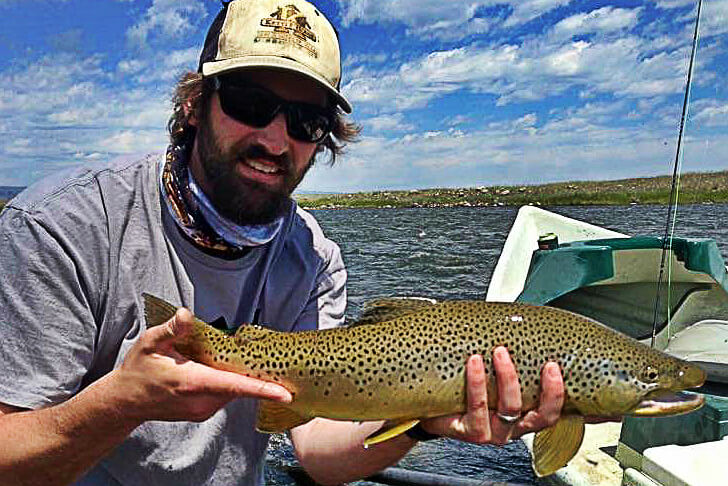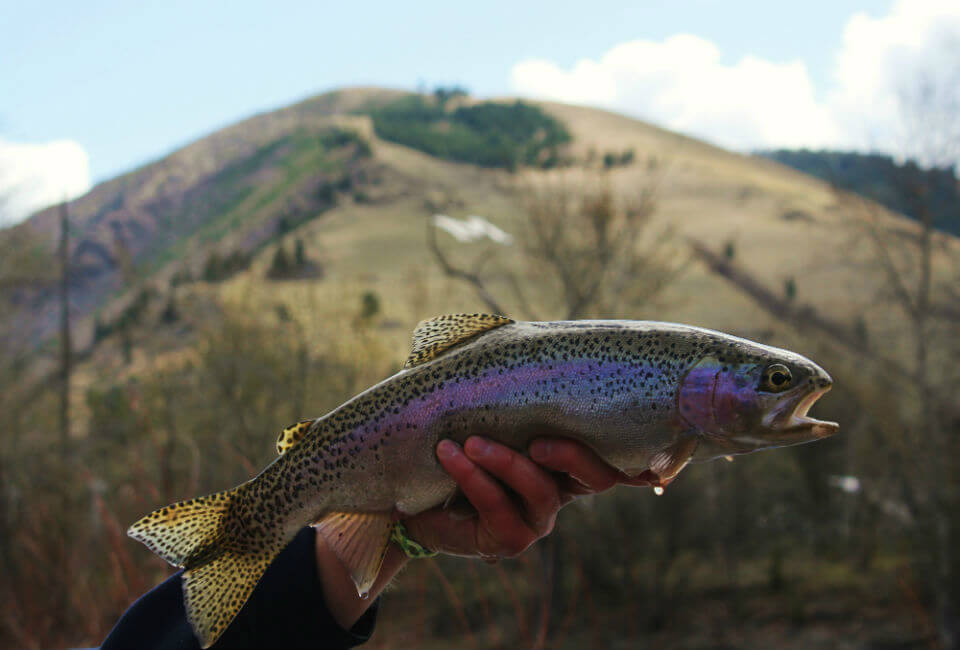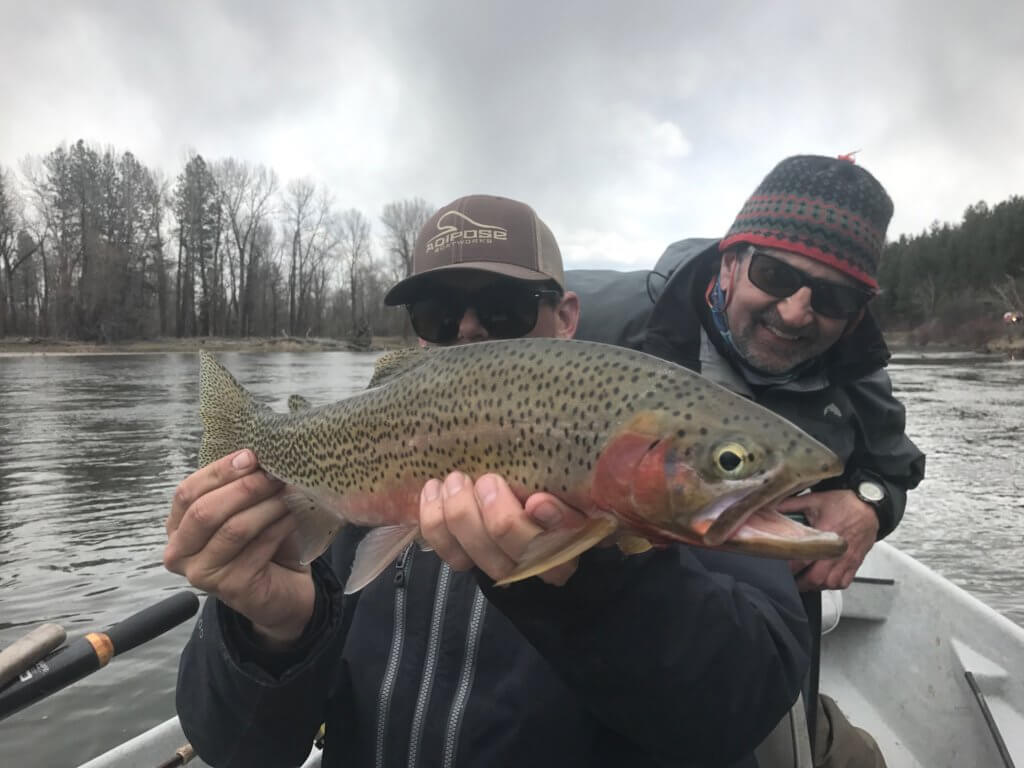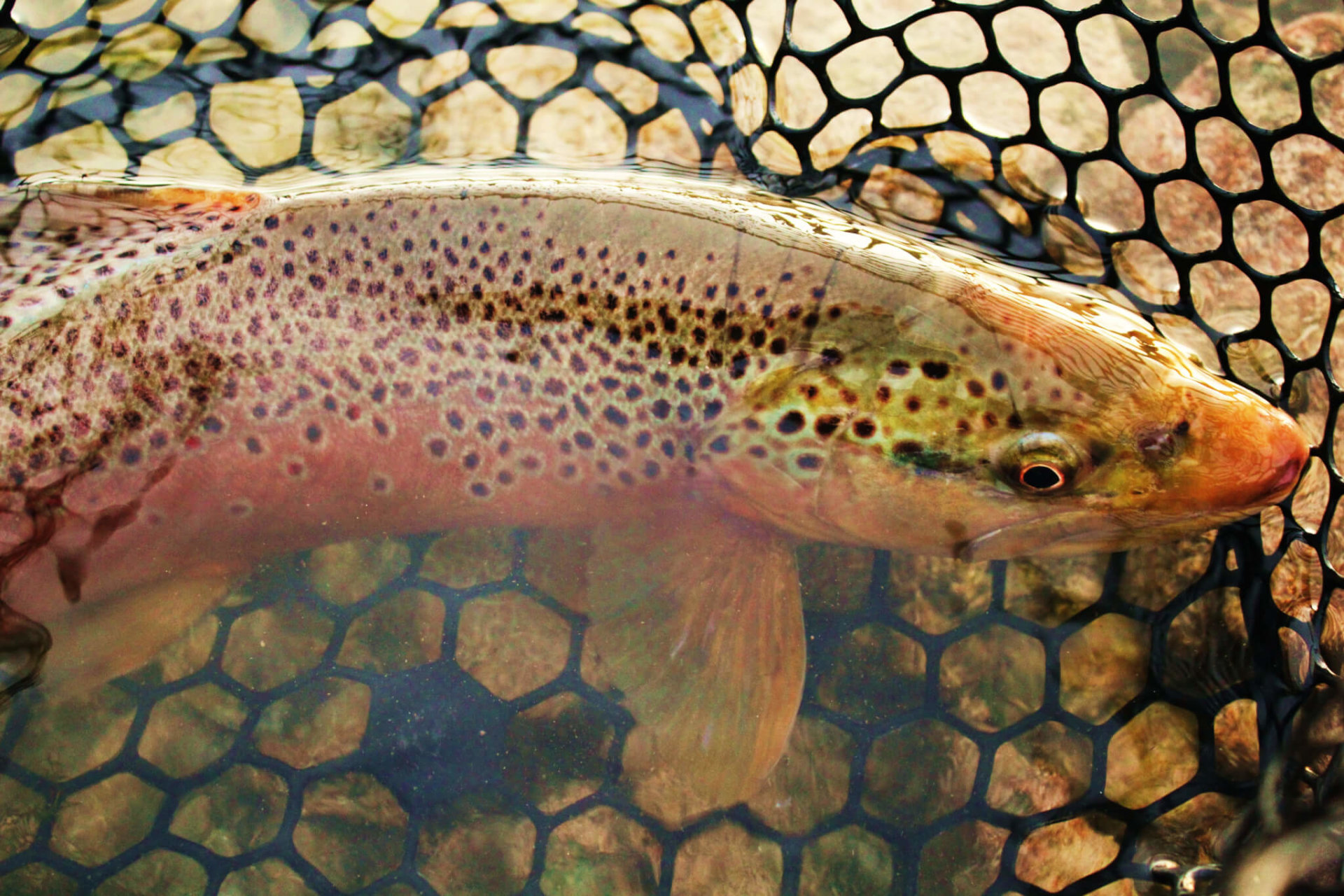Don’t panic. This is not about the trout’s digestive system- we could care less about that. This is about trout biology that will make us better fishermen. In fact, this is why you paid attention in Biology class in school, to be a better fisherman. So stick with this for a bit.
Trout have an IQ of 4. That’s it. Which is just about enough to get them through the only 3 tasks they have in their lives. The 3 things trout do are eat, try not to get eaten, and, in their season, make little trout. Because they have an IQ of 4, they can only accomplish 1 task at a time. So if a trout is spawning, it won’t eat, and is very difficult to spook. And if a trout is spooked (fleeing from predators) it is not eating. One thing at a time for our friend the 4 IQ trout.
Calorie Calculator
When you think of a trout, you probably think of a Rainbow Trout, or a Brown Trout (and usually with some size to it, if you are like me!) But what you should be thinking about when pondering trout is a calorie calculator. If a trout expends 6 calories in energy to take in 4 calories of food, it will die. Basic, but absolutely true. When trout are viewed this way, everything a trout does makes sense. (well, most everything- they are fish) Every decision it makes will be based on this fundamental tenet- where it is in the water column, how far from shore, etc. Unless a trout is spooked or spawning, the calorie calculator analogy always applies. So when a trout is feeding, (which is all the time) its actions and behavior can always be explained by the calorie calculator analogy.

Water Temperature
Trout are cold blooded. This means their body temperature matches their surroundings, unlike a mammal, which regulates its own temperature no matter what the external temperature is. Cold water slows down a trout’s metabolism, and a trout requires less food to support itself. As the water warms, a trout’s metabolism speeds up, and it requires more food. So, if you are fly fishing in the summer, a fish may range quite a ways for your offering., Because its metabolism is up, it needs the food, and it is not lethargic. But with colder water comes a more lethargic fish, as their metabolism is slower. So in colder water you need to get your fly right on top of your quarry, because they are not going to range very far to take your fly. So, cold means more accurate fly placement, because even if you have the correct fly, if it is not where the fish will eat it, it’s not doing any good. There are a lot of studies on trout and temperature, but let’s boil it down to this, a chart showing optimal temperatures for each species of trout. If the water temperature gets much above or below those listed, the trout become more difficult to catch.
Here is one other interesting trout/temperature fact. Trout feed best when the water is 62 degrees. And the more rapidly the temperature approaches 62 degrees, the more aggressively the fish will feed. So whether rising or dropping to get there, 62 degrees is the magic number.
Speaking of water temps, we all know when rivers get too warm, the trout are stressed, and if the water temperature gets too warm, the rivers will be closed to fishing to alleviate that stress. The reason the fish stress is lack of oxygen. Nothing lives in boiled water because boiling removes all the oxygen, and no living organism can survive without oxygen. And the warmer water gets, the less oxygen it can hold. So cold water holds more oxygen, and of course that helps the trout. Warm water = less oxygen = more stress. Imagine if you were walking down the street, and all of a sudden you lost ½ your oxygen supply. That would apply stress. And that happens to fish. As they move in the water, they are also looking for water that holds enough oxygen to survive. So, in warm weather and warm water temps, you want to fish in the riffles. Why? Because riffles act as natural aerators for the river. Wherever the water is churned up and bubbly, there is oxygen, and that’s often where fish are when the water is warmer, where they can breathe. Because breathing is a good thing.

Sight
Trout have eyes (Hey, that’s why you are reading this, for information you can’t get elsewhere!), and don’t ever believe someone if they say fish can’t see color. The rods and cones (the parts of the eye that govern light absorption and sight) in their eyes may be different from ours, so we don’t know how they actually perceive color, but they can sure tell color differences. Just float a trico through a Blue Wing Olive hatch and you’ll see. Also, fish can see colors in spectrums humans cannot see, so the UV spectrum is available to fish. So if you are a fly tyer, it doesn’t hurt to add some UV materials to a fly, as the fish can see those wavelengths. And they see well in the dark as well, so keep that in mind as well.
Remember people telling you that “Fish always bite better in the rain.” And you assumed it was just because it was raining, or the fresh water brought additional food into the river, or they simply liked the change in temperature. Well, it turns out, trout like clouds, because they have no eyelids, and little ability to adjust the size of their pupil. Bright sun is just plain uncomfortable to a trout. Also, millions of years has taught trout that they are more easily seen/vulnerable to predators on bright days, and that also a major factor in trout behavior. So in the summer, if a cloudy day rolls around, make sure to go fishing as you will often be rewarded with a lot of action.
Lateral Line
Trout also have a lateral line, which is a series of openings in their skin that identify changes in water pressure. They can use this lateral line to feel disturbances in the water, such as an angler clomping to the water, or feel the vibrations of a large fly in the water, such as a muddler or sculpin. Both those flies are dressed with a bulbous head that pushes a lot of water ahead of them, which the fish can feel and identify as prey. The lateral line is especially good to know about when fishing in off color water- that a fish can “feel” a bulkier fly make its way through the water. And of course trout can “feel” the fly in clear water as well, but given a choice, trout are primarily sight hunters, so in clear water, appeal to the eyes, but in off color water, appeal to the lateral line.
Predator Instincts
Another thing to keep in mind about trout is they are predators, with all that implies. As a predator, you have to work too hard to take prey in its prime, which screws up the calorie calculator. So a predator will always try and focus on the weak, the sick, or the vulnerable.
Nature is not neat or orderly, and things don’t always work out as planned. Some eggs don’t hatch. Most nymphs do not grow to maturity. And many mature nymphs do not complete their metamorphosis and become adults. When nymphs rise to the surface to become an adult, they encounter the meniscus (surface film), which they must break through. Breaking through the meniscus by a nymph has been compared to digging through 3 feet of dirt for us. Many insects do not succeed in breaking through, and thus failing to become a cripple. Once through the meniscus, an insect can be unsuccessful in inflating its wings, or be blown over by a sudden breeze, and again, go from a healthy, functioning adult to a cripple. And trout like cripples, because they can’t escape. And they like emergers, because they are vulnerable in their attempt to go through the meniscus.
When trout are actively feeding, they are searching for a place in the water where they can find an abundance of food, and be safe from predators. Unfortunately for the trout, these places in the water, where food and safety are together, are rare. So fish have to make choices, to move into more unsafe places to take in nourishment. Fish must follow the food. Food is not always found in the safe, sheltered places in the river, so the trout must come to the food. So when fish are feeding, they are often extremely skittish, more so than when they are in their zones of safety.

Prime Lies
Back to 4 IQ- the fish must feed, but often to do so, they must leave their comfort zones, so as soon as they feel unsafe, they flee. The places where food and safety are found together are called “prime lies”, and they are places where the bigger fish are found. The primer the lie, the bigger the fish. There are places in the river where big fish always are. These places consistently hold fish, because they combine the two things fish always need, food and safety. Certain lies are capable of holding 9 inch fish, other lies are capable of holding 15 inch fish. In these lies there will always be fish of this size, because that is all the lie can support. Year after year, these places hold fish of a certain size. That is called the holding capacity. Holding capacity can apply to an entire river (how many fish can a river hold) or to a specific lie in the river (how much food goes by to support a single fish).
Doing The Locomotion
The trout’s fins are used for every motion they make. The tail, or caudal fin, is the main means of propulsion, while the dorsal and anal fins are mostly used for balance. But it is the lower front fins, or Pectorals, that are so interesting. These are the fins that allow a trout to go up or down. And in a moving water situation, the main way a trout feeds is tilt their pectoral fins, and allow the current to push it in a path that intersects with the food. So when a trout rises, it angles its pectorals and pushed backwards by the current to the food, and then flicks its tail to return to the feeding spot. The only energy the trout expends is the tail flick to return. The rest is done by the current. However, remember that when you see a rise form, it is below where the trout is holding, so you must cast above the rise so the fish can see your fly. The adipose fin, that identifier of all things Salmonidae, what separates the trout and salmon from the “lesser species”, well, it’s just like an appendix- totally useless. Oh well.
The Thalweg
Simply put, the thalweg is the place where the river is moving fastest. In a river that was a perfect U, the thalweg would be found at the surface in the center of the U. We all intrinsically know this from our wading experiences in a river, the current is fastest in the middle, and slower at the sides.
But let’s look a little deeper. Unlike a lake, where fish must cruise to find relatively stationary food, in rivers trout maintain a position and allow the insects (food) to come to them. So water in a river works as a conveyor belt, delivering food to the trout. For easy math, let’s say there is one insect every linear foot on the river. If the river moves at 10 feet per second, the fish gets to look at 10 pieces of food per second. If the river moves at 1 inch per second, then the fish sees one insect every 12 seconds.
BUT. (And isn’t there always a but!)
It takes a huge expenditure of energy for a fish, to maintain its place in water moving 10 feet per second. Even if it was possible for a fish to eat all 10 insects going over each second, would it still be enough caloric intake to offset the energy used to maintain its position in the current? Conversely, it is very easy to stay put in the water moving 1 inch per second. However, is 1 bug every 12 seconds enough to sustain and grow the trout, even though there is so little energy expended to maintain that position.
Which brings us to what we call Fish Math, for lack of a better term. As a fisherman, you are searching for the point(s) in the river where the current is moving at just the right speed to bring enough food to the fish, but not so fast that the fish has to expend too much energy to stay there.
And keep in mind that this is exactly what the fish is doing all day long as well, searching for these perfect intersections of food and current speed. It is conventional wisdom that “rivers don’t fish well when they are rising’, but that they do fish well when falling. We think the thalweg helps explain this. As the water rises, the fish are forced to move from one comfortable spot to the next, trying to locate these current speed/food intersections. And as the fish has to constantly adjust to the new currents, they are moving a lot, and a constantly moving fish is not a feeding fish. But as the water drops, it often drops more slowly, allowing the fish to find a spot to stay and feed. This is why we go to the USGS web site and follow the river flows so carefully, trying to monitor the fluctuations of the river.
But just knowing the flow does not help, you need to know how much the flow has changed in a certain time period. An angler, describing a river they just visited, tells you it was flowing at 17,000cfs. (cfs is Cubic Feet per Second) That tells you nothing useful. The useful info comes when the angler says, “and it’s average flow is normally 3,000 cfs” Now you know he was there during run-off. Or he says the river was at 700 cfs today. Again, no real info. But if he adds that the previous day it was 350cfs, then you know that it poured down rain, the river has doubled in size, is probably off color, and you know the fish are off the feed. So the best way to understand the flows is to check the flow today, know the flow for yesterday, and view the change in flow as a percentage. If the flow is 990 today, and was 900 yesterday, it came up 10%. Which is probably not bad. You need to know the flow and what it was the day (or the past few days) before to glean any real info from river flow data.
But we digress from the thalweg, our jumping off point for this discussion. In our stylized drawing it is very simple to see the thalweg, it is at the center top of the U. But very few sections of a river are a perfect U. There are downed logs, rocks, depressions in the river bottom, undercut banks and a myriad of other current deflectors that change the position of the thalweg. Which is the start of reading the water. Learning how all these different streambed deflectors affect the flow and speed of the water at the surface throughout the water column is the first step to reading the water. If you want to see the underwater currents, follow Lee Wulff’s advice in his book Trout On A Fly, where he recommends attaching a 12″ piece of fl. pink ribbon to the end of your rod tip. Dip the rod tip into the water and watch the reaction of the ribbon. If it swings straight downstream- fast current. But stick the ribbon behind a rock or in a bottom depression, and watch the ribbon flutter and drop. Places where the ribbon flutters and drops will be places where the fish live, and places where the ribbon streams out are places where the trout are not. The ribbon allows you to create a visual picture of stream currents, and so go on to recognize these spots in any river or stream.

Reading The Water
The thalweg is the first step to reading the water. Reading the water is a term that describes looking at the water and identifying the places where a trout should live. Lee Wulff allows you to visualize the currents, but it is not always feasible to walk out and dip your yarn in the water. So you try to look at the water and “see’ the current. To do this, use a few different keys. One of the most important is the streams of bubbles on the surface. The streams of bubbles allow us to see the “seams”, places where 2 (or more) currents come together. Where currents come together, food sources come together, creating a larger food source. Remember that seams, while we are using the bubbles to identify them on the surface, will usually run as deep as the water, combining food sources both on the surface, and below. Seams are good, so learn to identify them.
Another important key is the color of the water. The darker the water, the deeper the water. Basic, but it needs to be said. As our fish biology taught us, fish usually need 2 things, access to food and safety from predators. Depth equals safety to a fish, So deep water will hold fish. But, shallow water is where photosynthesis takes place. A we all know, photosynthesis is the foundation of the food chain. So a lot of food is found in shallow water, and fish need food. But, food and safety are not always found together, so a fish needs to find just the right spot in the river- not too fast, not too slow, not too deep, not too shallow. Like we said, fish math. But when you learn to identify these spots on a consistent basis, you will begin to catch fish on a consistent basis.
Reading water is a skill best learned on the water, not from a blog. Tough words for an author to write, but true. There are many ways to read water but a different way of reading the water from Joan Wulff’s book Fly Casting. As a casting instructor, she stressed casting profanely. Provided one has good casting skills, she provides this method for fish location. Mentally break down a section of river into a grid. Cast your fly into each section of your mental grid, and see where you hook fish. Then look carefully at the places where you have located fish, and take in its features (water color indicating depth, bubbles indicating current seams, etc.) Then move along the river and try and locate different places with the same features where you hooked fish. This can be tedious, and you will fish some water that has no fish in it, but if you are having trouble reading the water, this method provides as close to a sure fire way of locating fish that I know of.

